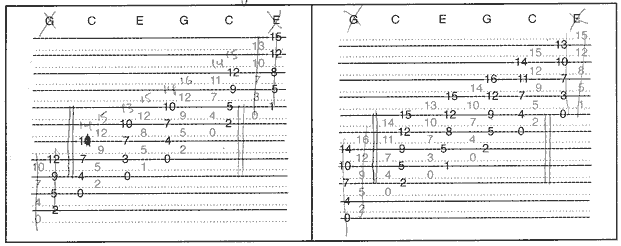
If one takes up making music with say, a baritone ukelele, when either too old or disabled to wrap one's fingers around the neck without pain, or unable to finger chords and notes on the frets without hitting more than one string per finger, there is tablature for thumbs. That's right, you play with your thumbs. Among the things you can play that way are: Amazing Grace, Streets of Laredo, House of the Rising Sun, Scarborough Fair, Shenandoah, Greensleeves, O God Our Help in Ages Past, The Beatles' Blackbird, and Ashokan Farewell. Some can be played on just one string. I don't recommend this approach for kids who can play to usual way - it might teach them bad habits. It's just for us clumsy people who have been defeated by any number of musical instruments and just want to be able to play something. Besides that, once you get reasonably good at it, it helps to lower blood pressure, heart rate and any paranoid fantasies you might have been having. Great before bedtime.
The Transcription Chart
To go from sheet music to thumb tablature, the first thing you have to do is to set up a transcription chart for your instrument. Let's start with something complicated to explain the transcription method and then go to songs on one string.

This chart shows one for a guitar tuned to G-C-E-G-C-E cut down to a ukelele tuned to C-E-G-C. The lowest note on the ukelele can start on a space or a line. Here the staff has been indicated by the five lines bracketed by sets of two parallel vertical lines. On the left, the lowest note sits on a line. On the right, it sits on a space. One simply finds the lowest and highest notes in the song and chooses the position of the staff so that the available notes on the strings and frets span the notes in the song. The lowest note is the most important restriction. I cannot say whether the left or right chart is better. Try both and see how it sounds. One or the other may sound a bit flat.
The next chart shows the opening line for , ASHOKAN FAREWELL by Jay Ungar, ©1983 by Swinging Door Music-BMI, using the transcription chart on the right.

Notice that it shows all the possible string-fret combinations for one note. In this form, unlike regular tablature, only one string at a time is plucked. One then has to choose from the possible combinations above which is the easiest to play. It helps to avoid having to hit frets too far apart, and to use one string as long as possible in a run of notes, or phrase. The circled phrases above indicate possible choices. I chose the ones below (and reversed the length of notes on the pair of 9 on the right):

Since sharps and flats don't always transcribe well with this method, don't be afraid to make some changes. I mistook the lowest note of Ashokan Farewell to be a half line higher than it was. Rather than redo the whole transcription, I rewrote the phrase it was in a note higher. Although that might make a real musician cringe, it sounds good enough for me. It's not like I'm going to be playing any gigs.
Songs on One String
In using this method, those of us who cannot really read sheet music and hear the notes in their heads should stick to songs they know. For many of us, that includes church hymns and folk songs, which often have simple, easy to play tunes, which can be played on just one string. Rock and roll, blues and jazz are often much more complicated. How-To music books can be very helpful, but be sure to get the ones that come with CD-ROMs with all the music played that appears written. In Tulsa, these are available from, among others, and Ewing Music, which has a huge stock of sheet music.
Songs that can be played on just one string don't need the full tablature. They can be played on one string in many guitar and ukelele tunings, but some strings will definitely sound flat. Any string will sound bad if not tuned properly. The E-A-D-G-B-E digital tuners cost about $10, but for tunings like C-E-G-C, a $20 chromatic tuner is best, and well worth the extra $10. Here are a few to get you started. They come with the fret numbers after the words or syllables. This assumes that you know the song and can provide the timing. If you don't, try to get a recording.
Amazing Grace, Blackbird, Greensleeves, House of the Rising Sun (partial), Love Me Tender, Our Help in Ages Past, Scarborough Fair, Shenandoah, Streets of Laredo.